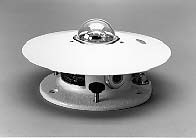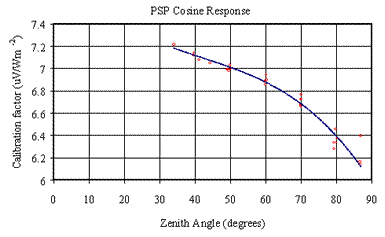Eppley Precision Spectral Pyranometer (PSP)
 The Eppley
Precision Spectral Pyranometer (PSP) is a World
Meteorological Organization First Class Radiometer, designed for the
measurement of total solar radiation (the sum of direct and diffuse). It
comprises a rectangular multi-junction wire-wound Eppley thermopile glued to the
back of the sensor disk. This disk
is coated with Parson's black lacquer (for non-wavelength selective absorption).
The dome consists of a pair of precision ground and polished hemispheres
of Schott optical glass. Both hemispheres are made of clear WG295 glass
which is uniformly transparent to energy between 0.285 to 2.8µm. Included
are a spirit level, adjustable leveling screws, and
a desiccator that can be readily inspected. The instrument has a cast bronze
body with a white enameled guard disk (shield).
The Eppley
Precision Spectral Pyranometer (PSP) is a World
Meteorological Organization First Class Radiometer, designed for the
measurement of total solar radiation (the sum of direct and diffuse). It
comprises a rectangular multi-junction wire-wound Eppley thermopile glued to the
back of the sensor disk. This disk
is coated with Parson's black lacquer (for non-wavelength selective absorption).
The dome consists of a pair of precision ground and polished hemispheres
of Schott optical glass. Both hemispheres are made of clear WG295 glass
which is uniformly transparent to energy between 0.285 to 2.8µm. Included
are a spirit level, adjustable leveling screws, and
a desiccator that can be readily inspected. The instrument has a cast bronze
body with a white enameled guard disk (shield).Specifications
| • | Sensitivity: approximately 9 µV/Wm-2. |
| • | Impedance: approximately 650 Ohms. |
| • | Temperature Dependence: ±1% over ambient temperature range -20 to +40°C. |
| • | Linearity: ±0.5% from 0 to 2800 Wm-2. |
| • | Response time: 1 second (1/e signal). |
| • | Cosine Response: ±1% from normalization 0-70° zenith angle; ±3% 70-80° zenith angle. |
| • | Weight: 7 pounds. |
| • | Orientation: Performance is not affected by orientation or tilt. |
Accuracy
The absolute accuracy of calibration is ±3-4%. The relative accuracy of calibration is about ±2%. Deviation from a true cosine response is the reason for the large absolute uncertainty in calibration.
Field performance
Yearly calibrations are useful because the responsivity of PSPs has been observed to deteriorate over time. The most accurate way to calibrate a pyranometer is to measure the direct normal beam irradiation with an Absolute Cavity Radiometer and the diffuse irradiance with a black and white pyranometer shaded by a disk. The direct normal data are projected onto the horizontal surface and the diffuse values are added to obtain the best estimate of the total (global) irradiance on the horizontal surface.
Cosine response of a PSP

For a PSP, the calibration factor varies with zenith angle. The cosine response of a pyranometer that has been in the field for 20 years is shown in the above figure. Each data point is the average calibration factor of data within a 10° bin, centered at the zenith angle of the data point, on a clear day in August or September, 1999. Because of the change in calibration factor with zenith angle, the National Renewable Energy Laboratory defines the calibration factor of a PSP as the average of calibration numbers obtained when the zenith angle is between 45° and 55°. The UO SRML currently uses calibration numbers obtained with the NREL definition. For the pyranometer in shown in the above figure the calibration factor is 7.00 µV/Wm-2, although the calibration number varies depending on the zenith angle. Notice that for any given zenith angle the standard deviation is much smaller than the overall standard deviation.
© 2023, UO Solar Radiation Monitoring Laboratory.
|
Top of page Site map Solar data Instruments Publications |
Home page Search About our data Software tools |
Sponsors Contact us Monitoring stations Educational material |
Home page URL: solardata.uoregon.edu
